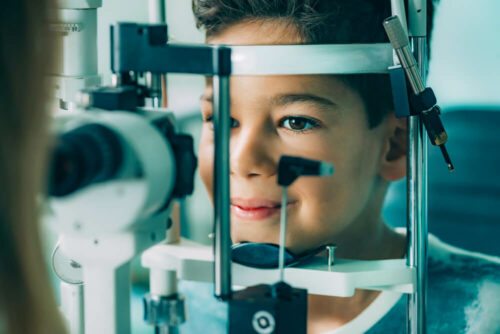
Your Child’s Eye Examination
Thank you for scheduling an eye examination for your child with our office. We hope that your visit to our clinic is pleasant and that we answer all of your questions. Even if you have had your eyes examined many times, there are a number of differences in the pediatric eye examination which we detail in this handout.
Preparing for the Visit
We understand that many children are apprehensive about visiting any doctor or are afraid that they will receive an immunization. You can assure your child that we will not use any needles to administer any shots. Your child may already know that we will be giving eye drops. You can prepare your child by explaining that the drops do not hurt, but that they feel like a drop of water going into the eye. If your child is seeing us for the first time, please be prepared for your visit to last, on average, one-and-a-half to two hours.
The Visit
During a child’s eye examination, a parent or legal guardian must accompany all children age 17 and younger. During the visit, eye drops will be given, and the verbal consent of a responsible adult is required. If a grandparent or other adult will accompany the child, then a parent or legal guardian’s written permission is required in order for us to give the eye drops and perform a complete exam.
After checking in at our reception desk, you will be given a health history form to fill out for your child, and will then be called back to the examination area by a member of our staff. Please let us know if your child has a preferred nickname.
Please also let us know at this time if your child has any issues with which we should be aware. Typical concerns would be if your child seems to you to be unusually apprehensive, or if your child has any medical condition which could affect the examination. For example, children with Down syndrome can be sensitive to some of the eye drops we use and also often dislike having their eyes covered or their faces touched. Children with autism often benefit from a different approach to the examination, which includes dimming the room lights and decreasing distractions in the room (which is the opposite of what helps most children to participate in an exam). Any health issue that you think is important is worth mentioning.
The initial examination will include a discussion of the reason for your child’s visit. If you have noticed any particular problem, we will ask you about its severity in detail. Please bring any photos of your child which demonstrate the problem-these can often be very helpful, particularly if the problem is variable.
Your child’s vision will be tested using one or more of several methods. For children who are verbal, this may include pictures, letter matching, or the full alphabet. We usually use an adhesive patch, which looks like an oval bandage, to cover the eye that is not being tested. This is because many children are skilled at peeking around normal adult eye covers.
As age and development allow, we will test your child’s depth perception and color vision. All children will be checked for the imbalance of the eye muscles. If any imbalance is noted or there is anything about the examination up to this point that is not completely normal, the doctor will see your child prior to dilation.
Next, your child’s eyes will be dilated. Most children require three drops. The first is a numbing drop, which helps to decrease the sting of the following drops. The next drop is a combination drop that includes two dilating medicines. This drop is given twice. Some African American, Asian, Native American, and Latino children require an additional drop or a repeat of these drops, due to their dark pigmentation.
The dilating drops that we use in children last longer than the drops we use in adults, on average 12 to 18 hours. We must use these drops because the muscle which we need to relax is “stronger” (it has more tone) in children than in adults. Whereas adults are able to tell us with great accuracy which prescription lens is best, children cannot. We need full relaxation of your child’s focusing system to accurately assess whether your child requires glasses or not. The vast majority of children are able to see clearly by the next morning; even if the pupils still appear a little dilated, the blurring effect of the drops has usually worn off.
The drops require, on average, 25 to 35 minutes to take effect. After this time, the doctor will check your child’s refraction (glasses prescription) and examine your child’s eyes, including the retina and optic nerve.
At the conclusion of the examination, the doctor will discuss his findings with you, offer his recommendations for treatment, and suggest appropriate timing for your child’s next examination. Please ask any questions you have. Feel free to bring a written list of questions if you like. The examination is not complete until all of your questions are answered. At the conclusion of the examination, the doctor may give you written instructions or additional handouts for your reference.
After the Visit
Once you return home, you may think of, or your discussions with friends and family may prompt additional questions. Please feel free to email through our patient portal or call our office any time with any questions you have. Our goal is that you understand completely your child’s condition and treatment.
We look forward to seeing you.

